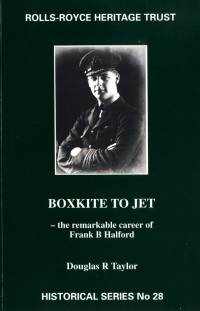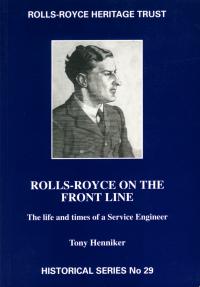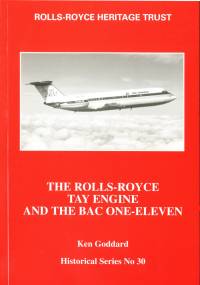Rolls-Royce Heritage Trust
Historical Series Reviews - Page 03
 |
Fedden
The life of Sir Roy Fedden
by Bill Gunston
Softbound, 208mm x 148mm x 21mm, 353 pages
ISBN: 978-1-872922-13-3
Rolls-Royce Heritage Trust
P.O. Box 31
Derby DE24 8BJ
England
Recommended Retail Price:
Please see Book List/Order Form
200 photographs
|
Reviewed by Doug Culy
This is one of the books that Rolls-Royce Heritage Trust has published to chronicle the product lines of companies that have been added to Rolls-Royce as it has survived the collapsing aerospace industry in Britain. Fedden, at 353 pages, is larger than any of the Trusts historical series. Roy Fedden, the Chief Engineer of Bristol Engines throughout most of its piston-engine era, is well described by Bill Gunston, one of the most knowledgeable aero-engine writers around. Gunston pictures how Fedden’s monomaniacal drive to perfect the aircraft engine enabled him to make a very difficult approach to engine design—sleeve valves—work better than anyone ever expected it to, and better than it has in anyone else’s engine before or since.
Fedden was responsible for more than 19 air-cooled radial engine models produced by Bristol Aero Engines and its predecessors, including the Jupiter, Pegasus, Perseus, and Centaurus. Production of these reached a grand total of 136,373 engines, a major fraction having sleeve valves. They powered many commercial and military aircraft models built around the world.
After Fedden “made” the Bristol Engine Department a success, the directors fired him for what amounted to insubordination because of his drive for perfection. This tension overlays the history of radial piston engine development at Bristol and its predecessors from WWI through the middle of WWII. Fedden was fired in October 1943, and continued working on technical committees and as a government technical expert for the rest of the war. Afterwards, he designed and built a small car with its engine, and a larger light-plane engine, hoping for production. When government support went away in 1947, Fedden was invited to join a NATO planning staff for a few years, and then joined Dowty as an internal consultant until 1960, when he was 75 years old. Fedden stayed active until he was at least 85, passing away in his 88th year.
Gunston’s book is full of anecdotes, details, and insights into many well-known personalities in Britain’s industry and government, as well as into the challenges of engine development in four eras: WW1, the inter-war years, WW2, and post-war.
A chart in the Appendix shows the evolution of Rolls-Royce, of which Fedden’s old employer is now a part.
 |
Boxkite to Jet
The remarkable career of Frank B. Halford
by Douglas R. Taylor
Softbound, 208mm x 148mm x 12mm, 221 pages
ISBN: 978-1-872922-16-3
Rolls-Royce Heritage Trust
P.O. Box 31
Derby DE24 8BJ
England
Recommended Retail Price:
Please see Book List/Order Form
76 photographs / illustrations
|
Reviewed by Doug Culy
This is one of the books that Rolls-Royce Heritage Trust has published to tell the stories behind the product lines of companies that have been added to Rolls-Royce as it has survived the collapse of the British aerospace industry. Boxkite to Jet is about a renaissance man of aviation engines, Frank Halford.
Halford was a principal contributor to the design of several WWI engines, the Cirrus engine, most of the de Havilland line of engines, piston, jet, and rocket, as well as most of the Napier line of piston engines, including the most powerful engine of its time, the Sabre. Before this, Halford raced motorcycles and was a pioneering airplane pilot. His technical acumen was early apparent as he devised improvements to foreign engines to supplement Britain’s meager supply of WWI aero engines in association with Harry Ricardo, the master of piston engine design. Halford was given rapidly increasing military ranks to reflect his responsibility and contribution.
At the end of the WWI, he designed a turbocharged motorcycle and started a consultancy that formed a unique bond with his manufacturing customers that was profitable to both. This independent consultancy continued through most of WWII, when it was absorbed into de Havilland.
This book has many details of the development challenges in getting these engines ready for production. It has nine appendices that supply biographies of all the personages he was involved with, aero engines ordered and delivered in Britain during WW1, aircraft and engines in the initial deployment of the RFC to France in 1914, the specs of all aero engines that Halford influenced, racing successes of Gipsy engines, a diary of the development of the Goblin jet engine, a tabulation of Halford patents, a list of the 19 Halford Memorial Lectures delivered through 1990, and the provisions of the Halford Scholarship. This book gives insight into the development of many lesser-known engines during the golden age of aero piston-engines.
 |
Rolls-Royce on The Front Lines
The life and times of a Service Engineer
by Tony Henniker
Softbound, 208mm x 148mm x 14mm, 285 pages
ISBN: 978-1-872922-17-1
Rolls-Royce Heritage Trust
P.O. Box 31
Derby DE24 8BJ
England
Recommended Retail Price:
Please see Book List/Order Form
100 photographs
|
Reviewed by David A. Paddock, P.E. (ret)
This autobiography, quite appropriately subtitled "The
life and times of a Service Engineer", is No. 29 in the Historical Series
published by Rolls-Royce Heritage Trust and The Sir Henry Royce Memorial
Foundation. Its 22 chapters cover his childhood, apprenticeship and subsequent
employment with the Aero division of R-R.
While very interesting as a personal account of his
life's events, it's written mostly for the British reader so that one has to
pause often to accommodate the idioms as well as the frequent chronological
excursions that sometimes make it difficult to follow.
Nevertheless, the narrative otherwise flows easily, and
Henniker takes us to a fascinating variety of places and assignments as he
performs technical support of the Kestrel and later R-R aircraft piston engines:
Germany in 1936-37 to fettle Kestrels for Junkers; South Africa and Southern
Rhodesia airlines with their Ju 52s and Ju 86s; back to England and then onto
France to support the RAF during the "Phony War" in 1939/40; then back to
England again and home service for the war.
There is very little technical discussion (an
autobiography is chiefly about its author, after all), although about 100
photographs accompany the text, many depicting little-known and esoteric
aircraft of the period that were powered by R-R engines. In addition, Henniker
provides a short but dramatic list of some 31 fighter pilots who served with
distinction and honor in the RAF and with whom he was personally acquainted.
Henniker is not particularly impressed with the French
Air Force but has joyful memories of the people he associated with during his
tour there. Needless to say, he believes the British Air Ministry was equally
lacking in competence at that time, too.
One matter I hoped the book would reveal is the means by
which an Englishman becomes an engineer, since the term is used vaguely in
England and appears to be generally applied to any person who is engaged in
making things and making them work — no formal, rigorous academic training is ever
mentioned. Henniker's story is that of apprenticeship for four years, including
some classes at Derby Technical College (which were not encouraged by the firm).
His apprenticeship, however, was rigorous, and involved learning a variety of
machine shop and foundry skills, and he was ultimately promoted to Aero Division
Service Manager, which is no small feat at Roll-Royce!
This book could very well take its place on the
bookshelves of R-R aficionados everywhere to lend a personal account of the
people who worked on the line for this great aero engine company.
 |
The Rolls-Royce Tay Engine
and the BAC One-Eleven
by Ken Goddard
Softbound, 208mm x 148mm x 8 mm, 129 pages
ISBN: 978-1-872922-19-5
Rolls-Royce Heritage Trust
P.O. Box 31
Derby DE24 8BJ
England
Recommended Retail Price:
Please see Book List/Order Form
27 illustrations
|
Reviewed by Doug Culy
This deceptively bland title hides a story detailing a very complex effort by about a dozen companies to market, develop and produce a re-engined BAC One-Eleven.
The most money was spent by the Dee Howard Co. of Texas, and its later owner, Aeritalia, in doing the conversion installation. BAC was the first to stir the pot, but later had only a minor role, as it came to believe its Model 146’s market would be unfavorably impacted by the success of the re-engined One-Eleven. Rolls-Royce should have been happy to sell Tay engines for this noble purpose of extending the useful life of the airframe, but seemed to be more concerned about who they were selling to. The Romanian airframe and engine enterprises wanted to do the production, but were hamstrung by their government. A Philippine airline would have been the source of the first batch of airframes to be re-done, but wanted a bigger slice of the pie. Several entrepreneurs tried to put together integrated organizations to do the total job, but failed to convince anyone they could get it done. Even the British and Romanian governments got involved.
Overall, this is an incredible tale that is hard to put down. The author confesses to not having all the facts, because many corporate files were destroyed, but having enough that he felt compelled to write the story. It was a shock to see how few were built. This reviewer agrees with the need to publish, as did the R-RHT.



